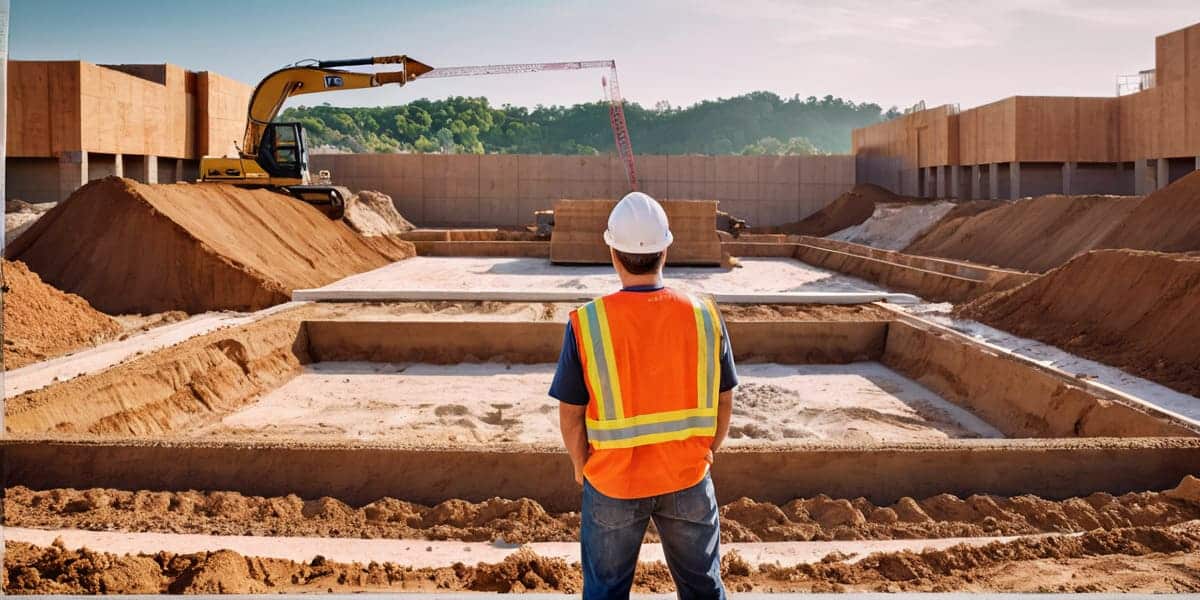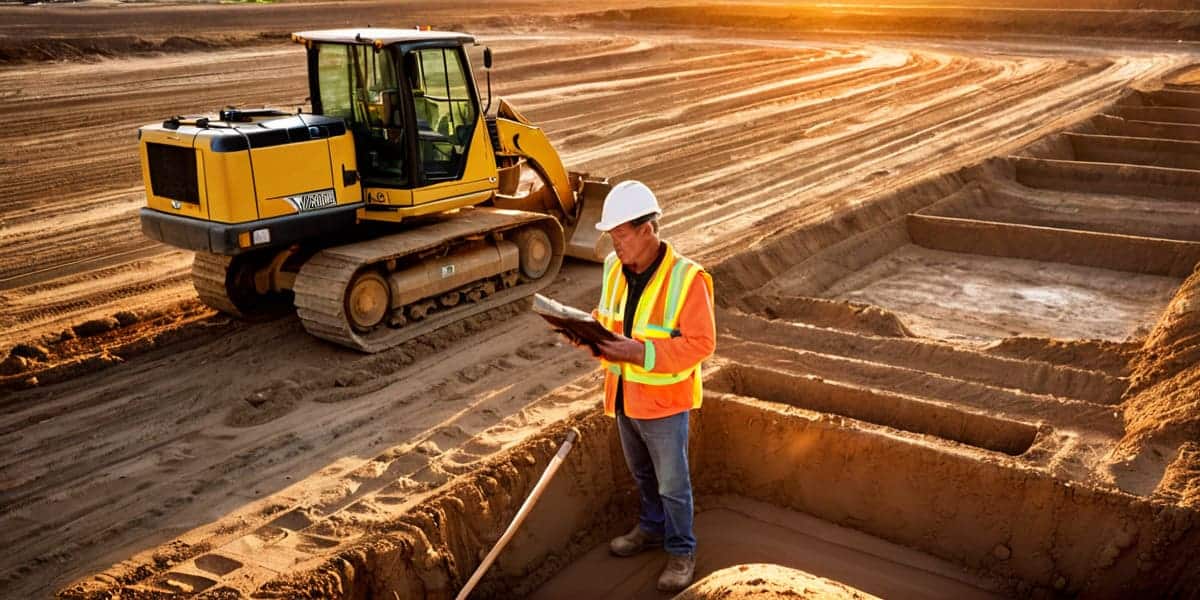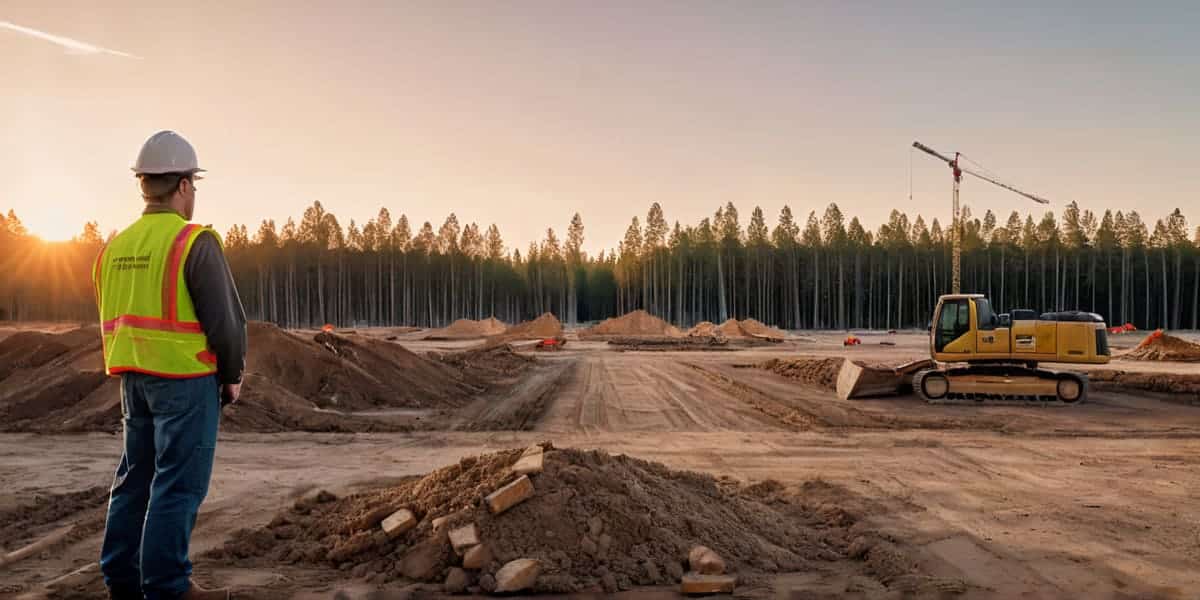 The Essential Guide to Site Preparation for New Construction
The Essential Guide to Site Preparation for New Construction

The Imperative of Site Preparation in Construction
Site preparation is the bedrock upon which the success of any construction project is built. It is a multifaceted process that involves a series of critical steps, each designed to ensure that the construction site is optimally ready for the subsequent build. This phase is not just about clearing the land; it’s about setting the stage for a project that is safe, efficient, and compliant with all regulatory standards.
Assessing the Impact of Site Preparation
Proper site preparation directly influences the stability, longevity, and safety of the final structure. It encompasses everything from soil testing and grading to securing the necessary permits. By meticulously preparing the site, construction companies and property developers lay a solid foundation for the entire construction process.
Risks of Neglecting Proper Site Preparation
The consequences of inadequate site preparation can be severe, ranging from structural failures to legal repercussions. Without thorough groundwork, companies may face costly delays, safety hazards, and potential litigation. It’s a scenario that underscores the necessity of a comprehensive approach to site preparation.
Setting the Foundation for Success
A well-prepared site is synonymous with a well-executed construction plan. It ensures that the project is built on solid ground, both literally and figuratively. From the initial environmental assessment to the final grading, each step is crucial for the project’s success.
Illustrating the Importance Through Narrative
The contrast between a well-prepared site and a neglected one offers a stark illustration of the importance of this phase. A narrative that highlights the meticulous planning and execution of site preparation showcases its role as the linchpin of construction success. It’s a storey of foresight, expertise, and the unwavering commitment to quality that defines the industry’s best practices.

Unveiling the Subsurface: The Role of Soil Testing
Before the first foundation stone is laid, soil testing stands as a critical first measure in site preparation. This process is not merely a formality but a fundamental step that informs the entire construction plan. Soil testing determines the soil’s ability to support your structure, identifying the soil classificationbe it A, S, M, H1/H2, E, or Pand revealing the need for any special construction techniques.
Why Soil Testing Is Indispensable
Soil testing is indispensable because it provides a scientific basis for all subsequent construction decisions. It reveals the soil’s bearing capacity, susceptibility to expansion and contraction, and drainage capabilities. Without this knowledge, you’re building blind, and the risks are manifoldfrom structural failures to unforeseen costs.
The Impact of Soil Composition on Construction
Soil composition directly influences the design and implementation of your project’s foundation. Different soil types react differently under load and environmental changes. For instance, clay-heavy soils (classified as M or H) can expand or shrink dramatically, which must be accounted for in the foundation design to prevent future structural issues.
Consequences of Overlooking Soil Testing
Skipping soil testing can lead to dire consequences, including compromised building integrity and potential legal disputes. It’s a gamble that can result in costly remediation or, in the worst case, complete project failure. As a property developer, the responsibility to ensure the safety and viability of the construction rests on your shoulders.
Informing Decisions Through Soil Analysis
The insights gained from soil testing guide the selection of appropriate construction methods and materials, ensuring the longevity and safety of the structure. It’s a step that cannot be bypassed if you aim for a successful build that stands the test of time and elements.
Navigating Legal Landscapes: Permits and Compliance
Before the commencement of any construction project, navigating the maze of legal requirements is a pivotal step. Permits and compliance are not just bureaucratic checkboxes but are safeguards that ensure the integrity and legality of your construction activities.
Understanding Permit Requirements
Permits act as a formal nod of approval from various authorities, confirming that your project meets all the necessary codes and regulations. Before breaking ground, you’ll need to secure a range of permits, typically including building permits, land-use permits, and environmental permits. Each of these serves as a green light that your project plans align with safety, zoning, and environmental standards.
Ensuring Compliance with Zoning and Environmental Laws
Compliance is a continuous process, not a one-time event. Construction companies must stay abreast of local zoning laws and environmental regulations, which can often change. Regular consultations with legal experts and local authorities can help you remain compliant and adapt to any new requirements.
Overcoming Challenges in Permit Acquisition
Obtaining permits can be a complex process, often involving multiple layers of bureaucracy. Delays can occur due to incomplete applications, lack of supporting documents, or backlogs at permitting offices. Proactive planning and thorough preparation of all necessary documentation can streamline this process.
Preventing Future Liabilities
Adhering to legal requirements is your best defence against future liabilities. It ensures that your construction project is built to code, preventing costly legal disputes and potential safety issues down the line. Compliance is not just about following the lawit’s about protecting your investment and reputation in the long term.

From Paper to Earth: Translating Site Plans into Action
The transition from site plans to tangible action on the ground is a meticulous process that requires precision and adaptability. Site plans serve as the blueprint for construction, detailing the vision of the project and the steps required to bring it to life.
The Role of Site Plans in Construction Coordination
Site plans are instrumental in orchestrating the myriad of construction activities. They provide a comprehensive layout that includes the placement of buildings, infrastructure, and landscaping. This visual guide ensures that every stakeholder, from architects to engineers to construction workers, is aligned with the project’s objectives and understands their role in the execution.
Resolving Discrepancies Between Plans and Site Conditions
Discrepancies between the theoretical plans and the actual site conditions are not uncommon. When such issues arise, it’s crucial to have a dynamic approach to problem-solving. Adjustments to the plan may be necessary, and this is where the expertise of surveyors and engineers becomes invaluable. They assess the situation, propose modifications, and ensure that the integrity of the project remains intact.
Illustrating the Site Preparation Journey
A narrative approach can vividly illustrate the journey from conceptual site plans to the physical groundwork. It’s a storey of transformation, where abstract lines and symbols on paper evolve into the bustling activity of machines and workers, all moving in concert to shape the future landscape. This narrative underscores the importance of each step in the site preparation process, highlighting the careful planning and execution required to turn a vision into reality.
The First Cut: Clearing and Grubbing Explained
Clearing and grubbing form the initial phase of site preparation, where the land is stripped of vegetation, debris, and existing structures to pave the way for new construction. This process is essential for creating a clean slate for the project and ensuring that the site is ready for further development activities.
Methodical Removal of Vegetation and Debris
Construction companies approach clearing with precision and care, methodically removing trees, shrubs, and other vegetation. Debris and any existing structures on the site are also dismantled and removed. This is done using a combination of heavy machinery and manual labour, ensuring that the site is cleared efficiently and safely.
Environmental Considerations During Clearing
Environmental stewardship is a key consideration during the clearing phase. Companies must adhere to regulations that protect wildlife habitats and preserve the natural landscape. Measures are taken to minimise the impact on the surrounding ecosystem, such as:
- Scheduling clearing activities outside of nesting seasons.
- Salvaging topsoil for reuse.
- Implementing erosion control measures.
Addressing Challenges with Solutions
The challenges of site clearing, such as managing large volumes of waste and preventing soil erosion, are addressed through strategic planning and the use of specialised equipment. For instance, mulchers and chippers can reduce vegetation to mulch, which can be used for erosion control or landscaping, turning a challenge into a resource for the project.

Levelling the Field: Grading and Excavation Techniques
Grading and excavation are pivotal in preparing a construction site, setting the stage for a stable foundation and effective drainage. These processes are tailored to the unique topography of the site and the specific requirements of the project.
Tailoring Techniques to Terrain
The terrain dictates the grading and excavation methods employed. Flat landscapes may require minimal grading, while hilly areas might need extensive cut and fill techniques. The project scope also influences the strategylarger projects may necessitate more significant earthmoving and soil stabilisation efforts.
Overcoming Grading and Excavation Challenges
Common challenges in grading and excavation include managing excess soil and preventing erosion. Solutions involve soil testing to determine the best use of on-site materials and employing erosion control measures like silt fences or sediment basins.
Ensuring Structural Longevity Through Proper Grading
Proper grading is not just about creating a level surface; it’s about ensuring that water drains away from the construction site, preventing foundation damage and soil erosion. A well-graded site directs water to designated drainage areas, safeguarding the site’s integrity and contributing to the longevity of the construction.
Foundation Selection: Tailoring to Site Conditions
Selecting the right foundation is a critical decision in the construction process, one that hinges on the unique characteristics of the site. Construction companies must weigh various factors, including soil type, water table level, and load requirements of the structure, to determine the most suitable foundation.
Comparative Advantages of Foundation Types
Different foundation types offer distinct advantages. Slab foundations may be cost-effective and quick to construct, while pier and beam foundations allow for better access to utilities and are suited for sites with expansive soils. Crawl spaces can provide easy access for repairs and increased protection from soil moisture.
Site Conditions Dictating Foundation Choices
The choice of foundation is directly influenced by the site’s soil conditions. Soil tests that reveal a high clay content may necessitate a deeper, more robust foundation, while sandy soils might require specialised techniques to ensure stability. The presence of a high water table could also dictate the need for waterproofing measures.
Decision-Making in Foundation Selection
The decision-making process for foundation selection is a narrative of balancing cost, time, and quality. It involves collaboration between engineers, architects, and construction managers, all bringing their expertise to the table to ensure the foundation chosen aligns with both the project’s needs and the site’s constraints.

Integrating Infrastructure: Utility Planning in Site Preparation
Utility planning is a critical component of site preparation, ensuring that essential services are accessible for the new construction. This integration is a complex task that requires foresight, coordination, and a deep understanding of both the project’s needs and the site’s characteristics.
Guiding Considerations for Utility Layout
When planning the layout for utilities such as water, electricity, and sewage, several considerations come into play:
- Proximity to existing utility lines: To minimise costs and disruption, aligning with existing infrastructure is preferred.
- Future accessibility for maintenance: Utilities should be laid out in a manner that allows for easy access for future repairs and upgrades.
- Environmental impact: The layout must consider the natural landscape to minimise ecological disturbance.
Coordination with Utility Providers
Construction companies must work closely with utility providers to ensure that the installation of services aligns with the overall project timeline. This coordination involves:
- Scheduling: Aligning utility installation with the construction schedule to prevent delays.
- Compliance: Ensuring that all utility work complies with local codes and regulations.
- Communication: Maintaining open lines of communication to address any issues promptly.
Best Practices in Utility Planning
A comparative analysis of utility planning across different projects can reveal best practices, such as:
- Early engagement: Involving utility companies from the outset can prevent costly rework.
- Flexibility: Designing utility plans that can adapt to changes in the construction project or unforeseen site conditions.
- Documentation: Keeping detailed records of all utility layouts for future reference.
Paving the Path: Access Road Design and Construction
Access roads are the arteries of a construction site, providing vital connectivity for personnel, machinery, and materials. The design and construction of these roads require careful consideration of several factors to ensure they meet the demands of the project.
Factors Influencing Access Road Design
The design of access roads is influenced by:
- Site topography: The natural lay of the land dictates the route and construction methods.
- Traffic load: Anticipated vehicle types and frequency determine road width and pavement strength.
- Project duration: Temporary roads for short-term projects may differ from those intended for long-term use.
Ensuring Road Durability and Functionality
To ensure the durability and functionality of site roads, construction companies:
- Use appropriate materials: Selecting the right base and surface materials to withstand expected traffic.
- Implement proper drainage: Designing roads with adequate drainage to prevent water accumulation and damage.
Overcoming Road Construction Challenges
Challenges such as uneven terrain or limited space are overcome by:
- Engineering solutions: Employing retaining walls or grading techniques to stabilise the road.
- Innovative design: Creating switchbacks or adjusting road alignment to fit the available space.
The Narrative of Access Road Construction
The construction of access roads is a critical chapter in the site preparation storey. It sets the stage for all subsequent construction activities, ensuring that the site is accessible and functional. This narrative underscores the importance of thorough planning and execution in the early stages of a construction project.

Embracing Sustainability: Green Practices in Site Preparation
Sustainable practices during site preparation are not just beneficial for the environment; they are increasingly becoming a standard in the construction industry. Companies are recognising the long-term value in integrating eco-friendly methods from the outset of their projects.
Critical Sustainable Practices
During site preparation, several sustainable practices are critical:
- Erosion Control: Implementing measures to prevent soil erosion, protecting water quality and surrounding habitats.
- Waste Management: Strategically recycling and disposing of waste materials to minimise environmental impact.
- Resource Efficiency: Using materials and resources efficiently to reduce the carbon footprint of construction activities.
Balancing Development with Environmental Stewardship
Construction companies balance development with environmental stewardship by:
- Conducting Environmental Assessments: Evaluating the potential impact of construction on the local ecosystem and adjusting plans accordingly.
- Adopting Green Technologies: Utilising equipment and techniques that reduce emissions and energy consumption.
Benefits of Green Site Preparation
Incorporating green practices into site preparation offers several benefits:
- Cost Savings: Efficient resource use can lead to reduced material costs and potential tax incentives.
- Regulatory Compliance: Meeting or exceeding environmental regulations can avoid fines and facilitate smoother project approval.
- Reputation Enhancement: Demonstrating a commitment to sustainability can improve a company’s image and appeal to eco-conscious clients.
Addressing Environmental Concerns
A problem-solution narrative effectively addresses environmental concerns in construction by:
- Identifying Challenges: Recognising potential environmental issues early in the site preparation phase.
- Implementing Solutions: Applying sustainable practices as standard procedure to mitigate these challenges.
Prioritising Health and Safety During Site Preparation
Ensuring the health and safety of workers and the public is paramount during the site preparation phase of construction. Construction companies are tasked with implementing comprehensive safety protocols to mitigate risks and create a secure work environment.
Essential Health and Safety Protocols
A robust safety plan includes:
- Personal Protective Equipment (PPE): Mandating the use of helmets, safety vests, goggles, and other PPE to protect workers from potential hazards.
- Safety Training: Providing regular training sessions on safety practices and emergency response to all personnel on site.
- Environmental Protection Plans: Establishing measures to safeguard the surrounding environment from construction activities.
Mitigating Risks to Workers and the Public
To reduce risks, construction companies employ strategies such as:
- Regular Safety Audits: Conducting frequent inspections to identify and rectify potential safety issues.
- Clear Signage: Installing signs to warn of dangers and direct traffic, both vehicular and pedestrian, safely around the site.
Addressing Common Safety Challenges
Common safety challenges, such as working at heights or operating heavy machinery, are addressed by:
- Implementing Fall Protection Systems: Ensuring that guardrails and safety nets are in place where necessary.
- Equipment Operation Training: Certifying that all machinery operators are trained and competent to handle the equipment they are using.
Emphasising Safety Through Narrative
Storytelling can be a powerful tool to emphasise the importance of safety. Sharing real-life scenarios where safety protocols prevented accidents or minimised injuries can reinforce the value of a vigilant safety culture on construction sites.

Cementing Success: The Pivotal Role of Site Preparation
Mastering site preparation is akin to laying a strong foundationnot just for the immediate structure but for the enduring success of construction companies. It’s a meticulous process that, when executed with precision, can prevent costly overruns and delays, ensuring projects are delivered on time and within budget.
Lessons in Site Preparation for Property Developers
For property developers, a comprehensive guide to site preparation offers invaluable lessons. It emphasises the importance of due diligence, the intricacies of navigating legal frameworks, and the benefits of investing in thorough groundwork. These lessons become the bedrock of future development strategies, ensuring resilience against potential construction pitfalls.
Adapting to Evolving Construction Trends
As construction trends evolve, so too must site preparation strategies. Innovations in technology and shifts towards sustainability are shaping new best practices. Developers and construction companies must remain agile, adapting their site preparation methods to incorporate green materials, smart technology, and advanced machinery to stay at the forefront of the industry.
Reflecting on Site Preparation Narratives
Reflecting on the narrative of site preparation provides a roadmap for future projects. It allows developers to analyse past successes and challenges, fostering a culture of continuous improvement. This reflection is not just about learning from historyit’s about writing the future chapters of construction excellence.

